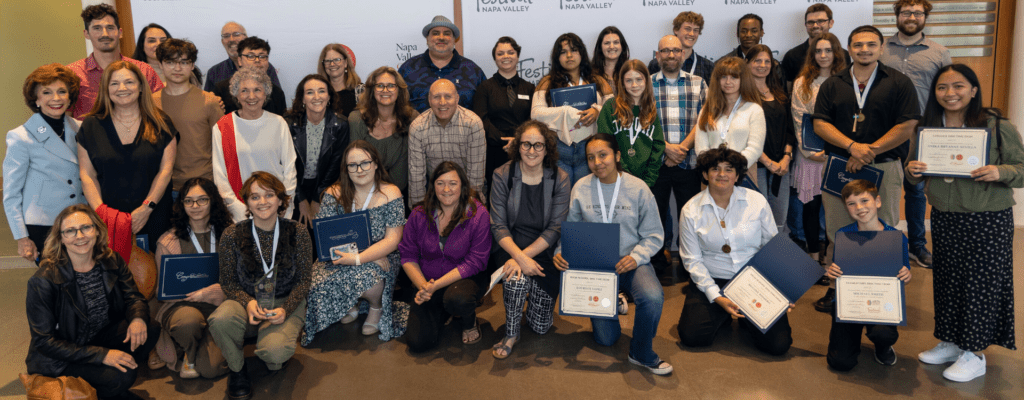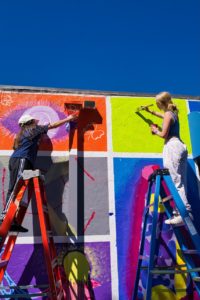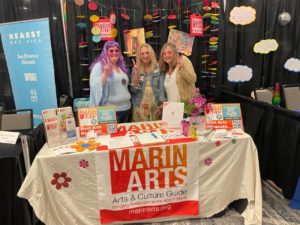The creative economy in the North Bay is far more of an economic driver than many realize. But to have a strong creative economy, there must be a strong arts community—and for that to happen it helps to have a strong arts curriculum. Unfortunately, California has been struggling with weakened arts education since 1978, when the passage of Proposition 13 lowered the state’s property tax revenue, resulting in steep budget cuts to public schools.
Across the North Bay, many nonprofit organizations have been working to support the arts in their communities. We spoke with representatives from three of those organizations from Sonoma, Marin and Napa counties about the work they’re doing to revitalize the arts.
Creative Bridges
In Sonoma Valley an organization called Creative Bridges—online at creativebridges.org—is working to reinvigorate arts education in the schools. They’re doing it with an alliance of people and organizations who are collectively working toward the same goal of getting the arts to all students in the community.
Founding member and co-chair Connie Schlelein says the Creative Bridges alliance began to loosely take shape in 2018. “It was a twinkle in many of our eyes as we realized there was synchronicity in our speaking about how many arts organizations in the valley and the public wanted arts education,” she says.
“But a lot of these organizations were working in their own silos,” Schlelein says.

Since officially launching in 2021, Creative Bridges has provided a way for all such entities to work together to help create the change they want to see. The alliance strategically advocates for strong arts education in the schools.
Schlelein co-chairs the organization along with Sonoma Valley Unified School District arts teacher Cheryl Coldiron, also a founding member of CB. The two working together help form an alliance between the community and school district, and it’s one of the many powerful partnerships within the organization.
“We have helped show SVUSD the huge public will the entire community has for arts education in this valley,” Schlelein says. “As solution partners, CB has worked with the district’s visual and performing arts teachers to help them develop a strategic roadmap to improve and expand arts education.”
The alliance itself is not a provider of arts programs or services. “Some of the alliance organizations individually provide services to the community or the schools—with teaching artists, after-school visual and performing arts instruction and showcases,” Schlelein says.
Many of the alliance’s arts organizations were previously competing with one another in their fundraising and arts activities. Its members now have an opportunity to build community among themselves, creating relationships with one another and working together in their efforts.
“Bottom line, we ask if what we’re doing is good for kids,” Schlelein says. “Everything else we can figure out because we’re creative people, so we’ll figure it out.”
Schlelein is a retired arts educator who has served as vice president of the National Art Education Association. When she moved to the area from Colorado she realized that California’s schools were suffering from the fallout of Prop. 13, which led to lowered funding for arts education in California schools. She wanted to help.
She began by working with Creative Sonoma, the County of Sonoma’s arts division, in its efforts to create a strategic master arts plan: the Sonoma County Framework. Schlelein then focused her efforts on the Sonoma Valley area when she realized that many of her neighbors had the same vision to reinvigorate the arts curriculum in local schools.
“In these past few years, one coffee at a time, we have shown people that school districts can change and it takes collective impact,” Schlelein says. “It takes a community, a whole community coming together and speaking for what they want.”
Schlelein concedes that people can become “frustrated with institutions,” but believes CB’s most important achievement is its ability to bridge groups. “We’re Creative Bridges,” she says. “It’s not just a bridge over one thing. It’s a multidimensional bridge to all these organizations and all these parts of the community, so that we can improve things for kids.
“This isn’t just me, this is collective, it is collaboration, these relationships,” Schlelein says.
Currently the alliance includes around 47 organizations and individual members and that number is continually growing. This includes nonprofits, arts for profits, interior designers, consultants, art galleries, art museums, dance studios, theater companies and more. Schlelein said that many of the businesses involved are not arts-related, but they know that the arts are important for the community, for creativity and critical thinking.
Schlelein is also a member of Sonoma’s Cultural and Fine Arts Commission and in December she gave a presentation to the city’s Parks, Recreation and Open Space Commission about creating community that supports the creative economy.
In 2015, Americans for the Arts included Sonoma County in its Arts & Economic Prosperity 5 national study of the economic impact of the nonprofit arts and culture industry. According to the study, $80.4 million had been generated in annual economic activity in Sonoma County by 42 nonprofit arts groups and there were 2,684 full time jobs created by those 42 nonprofit arts groups.
Schlelein says another exciting thing is that cultural tourists spend three times the money that wine tourists do. “So if you enhance the culture of your community, then that’s really beneficial to communities,” she says.
“Cultural tourists stay three times as long as wine tourists, and they’re often the same target audiences,” Schlelein says,” So both for people that are living in the community and for people that are visiting the community, the arts are important financial drivers.”
The Sonoma County Office of Education created its “Portrait of a Graduate” that illustrates the hopes for six important strengths that students would have when they graduate. Those strengths include curiosity, empathy, communication, initiative, to be ethical and engaged, and to be good at collaboration. All of these skills are strengthened by the arts.
Schlelein says that Proposition 28—aka the Arts and Music in Schools Funding Guarantee and Accountability Act approved by voters in 2022—will be helpful in restoring arts education in California.
“Prop. 28 doesn’t solve everything because it’s been 45 years of neglect since Prop. 13 [led schools to] cut the arts in California,” she says. “It’s a lot of time to have to make up and a lot of damage has been done. A lot of generations have had inadequate critical and creative thinking education.”
With Prop. 28 funds, the Sonoma Valley Unified School District is preparing to hire elementary teachers, restore arts teachers, restore classrooms and buy equipment.
Schlelein says the next big push will be in finding those arts educators, since many would-be arts instructors entered other fields because of the lack of teaching jobs in the arts in recent years. “People that are photographers or videographers or animators or musicians—there are pathways for them to become teachers,” she says.
“We’re starting at the elementary level and we’re rebuilding, but kids are going to get turned on and there’s a whole lot of innovation with small companies now in tech,” Schlelein says. “I think this is going to be a major boost for the creative economy in California, and we have one of the greatest creative economies in the world. Can you imagine if we can improve our education system, what it’s going to be like?”
Schlelein says they are showing the community the way to help with positive change. “I have to tell you the school board meeting that we presented to two weeks ago was almost like an emotional eruption,” she says. “After our presentation, the board took a break and the entire room went into a group hug. It was just riveting, you know, exhilarating.”
Schlelein believes it will be a positive result for arts educators who have been “neglected” for years. Next fall, local classrooms will start to see weekly art and music again, especially at the elementary level, she says.
“Everyone is creative, and everybody has the ability to grow their creativity and critical thinking,” Schlelein says. “They just need to [have] the right guidance to do that and that really benefits our planet.”
Arts Council Napa Valley
The Arts Council Napa Valley (ACNV) is supporting the arts and arts education through grants, a creative directory and education alliance, helping to create equitable and inclusive access to the arts for all students in Napa County.
Crysta Tim, programs and administration manager for Arts Council Napa Valley, says it’s important the community understands that art isn’t like a decoration. “It’s key to cultural movements, political movements, just making a place have personality and character and bringing people together.” she says. “It’s a lot more than just something extra. It’s something essential, and that’s just really important for the community to understand and be a part of.”
She describes arts education as “kind of a constant battle.”
“As funding comes up, sometimes it doesn’t go to the right place,” says Tim. “But we’re always at the door trying to make sure things are going where they should go and we’re advocating for the teachers and the kids.”

Tim says the arts programs are getting smaller and smaller, but ACNV is doing what it can to try and fill the gaps that come up. “We do the Student of the Year program to help fill those gaps,” she says, as an example.
For Student of the Year, they reach out to teachers across Napa County to get nominations for students excelling in visual and performing arts or creative writing. Each month the winning students are then in the running for “student of the year” in different categories and grade levels. At the end of the school year ACNV hosts an awards ceremony and the winners are awarded scholarship money.
ACNV also has an arts-and-culture event calendar—artscouncilnapavalley.org. “We are constantly looking for new things to add to that so people can keep up to date with what’s going on in the county,” Tim says.
They host an “opportunities board” for artists to find grant opportunities, professional development and job listings. They also help with referrals for artists and advocate for artists and programs.
“As the years go on and more projects are supported and more artists are coming into the fold, I think it’s blooming into us seeing more cultural projects,” Tim says. “In the past couple of years, we’ve supported a lot of Latino and Hispanic cultural projects. There have been murals, and galleries and there was a car show that we also supported.”
She says cultural art is “blossoming” in the community.

“I hope that continues as a growth pattern because people outside the county should know there’s a lot more culture and a lot more vibrancy than just, you know, our vineyards,” says Tim. “They’re beautiful, and it’s a wonderful part of the county, but there’s more to Napa County than that.”
Tim says that the organization did what it could to help students, local artists and arts organizations during the pandemic. When school performances had to be canceled, they set aside funding for repayment of ticket sales.
Arts Council Napa Valley worked with the school district, the Boys and Girls Clubs of Napa Valley and the di Rosa Center for Contemporary Art to conduct art-supply distribution for kids who were attending classes online from home during the pandemic. “The parents would drive the kids and come pick up kits for different art projects,” Tim says.
“It was quite a day when we were getting everything packed for the art-supply distribution,” Tim says. “That was a long day, but it was really gratifying, too. That was boots-to-the-ground kind of energy and it was nice. I was working with teachers that I had when I was a kid to pack up the supplies and stuff, so it was really cool.”
While ACNV funds programs, the nonprofit not involved in the functioning of the program, explains Tim.
“But I try and go see the show or be involved in some kind of way outside of just being a funder,” she says.
One of the ways Tim gets involved beyond her work with the Arts Council is by helping out with student murals in the summer. She spends her Saturdays with another Napa arts organization, the Rail Arts District (RAD) and RAD Wall Coordinator Kara Harrington, to help students paint murals.
Each summer, Devine Paint Center in Napa hosts a wall for student murals and Tim is there with Harrington to help make sure kids know how to use the art supplies and nobody’s falling off ladders.
The grid for the murals goes all the way up to the top of the building. “They have to use these big ladders and you’ve got middle schoolers on these ladders. It’s kind of scary,” says Tim. “So we have a few people onsite to just help out, make sure the kids are safe. I plan to continue coming back and doing it every summer until they tell me to go away.”
Tim says it’s important that arts in the schools gets built back up. “[We need to ensure] that we’re not further diminishing the importance of art in school and making sure that we build back up these programs that are suffering and getting cut,” she says.
Cutting programs for younger grades causes a ripple effect later one, says Tim. “It doesn’t matter if there’s a band program available in high school if the kids weren’t able to start in middle school—[because then] they’re not prepared for the high school level.”
Adds Tim: “It’s essential for these kids to have creative outlets and not just all the core programming, because it changes their motivation to come to school and participate.”
MarinArts
In Marin County, locals were able to continue supporting local artists and the arts community during the pandemic even as everything shut down. That’s because one organization had created an online calendar, a hub for the community to post and find arts events.
Since 2017, MarinArts has provided a free online calendar—marinarts.org—where artists and arts organizations across Marin County can list their programs. The calendar is available in 11 different languages making the arts accessible for more of the community.

Mary O’ Mara, the director and co-founder of the organization, says she’s very passionate about the arts in Marin. “We’re a service organization at MarinArts,” O’Mara says. “We support the arts. That’s what we do.
“We really reach out and try to make sure that every artist or agency or arts program is on our site,” O’Mara says. “We also just want people in the community to understand how much there is to do here so they can get out and have a really full and meaningful life.”
The calendar was able to survive with very little funding through COVID because they were online. They were able to support arts organizations by letting people know that although events were closing, a lot was available through online streaming.
O’Mara says they were lucky because they were already there and have about 4,500 email subscribers and around 14,000 web page views per month. “They’re very loyal readers,” she says. “A lot of our emails reach more people than we know because people send them out to others and we hear about it when we’re out and about and tabling and in the community.”
O’Mara says that tabling at art festivals and other events has been another great way to get the word out about MarinArts, as well as encouraging locals to support the arts.
“I could wax eloquently about why the arts should be supported but I think that mental health has become a very large one, coming out of COVID,” O’Mara says. “People are learning that the arts actually have a huge benefit for the emotional and mental health of our beings on the planet.”
“I think that the health of the arts is the health of the community,” O’Mara says. “If the arts are healthy, then that shows a healthy community, and I think that resonates throughout the world.”
O’Mara says she sees a direct influence upon local businesses by those attending arts events.
“If you think about it, people who go out to the arts, to the symphony, to the ballet, to the theater, to movie theaters, they spend money in restaurants and walking around in shops and are supportive of other venues and businesses,” she says.
People often go out to dinner before a show, or pick up food afterward to take home. O’Mara pointed out that restaurants have been suffering because fewer people have been out and attending events.
“Businesses do suffer when the arts suffer,” O’Mara says. “It’s kind of a domino effect.”
“We’re starting to see a lot of creativity bubbling up from lots of different people who created a lot of art during COVID,” O’Mara says. “I think the art shows are amazing. I think there’s a lot of interest from the artists and the arts community and also supporters for open studios and the different venues.”
O’Mara says we have a new normal now and she encourages everyone to think about where they appreciate art. “Whether it’s the library, art gallery, store or even an artist, get in touch with them and participate—just show up—buy something or donate,” she says.
“I just think that we should celebrate how lucky we are to have this wonderful art world here,” O’Mara says. “We should open our minds and our eyes to supporting them, because without them the vibrancy of this community would not be as rich.”


